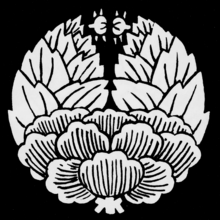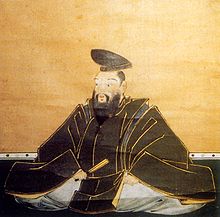Tsugaru (clan)
The Tsugaru ( Japanese 津 軽 氏 , Tsugaru-shi ) were a family of the Japanese sword nobility ( Buke ), of unknown origin in the north of Honshū . Some suspect a descent from Fujiwara no Tadamichi while others see a Japaneseized Ainu tribe as a possible origin. With an income of 217,000 Koku , the Tsugaru residing in Hirosaki ( Aomori Prefecture ) belonged to the great Tozama daimyo of the Edo period .
The Tsugaru controlled the northern Japanese prefecture of Aomori . They grew their loyalty several times between the pro-imperial government and the Ōuetsu Reppan Dōmei , the Northern Alliance , which later proclaimed the Republic of Ezo .
genealogy
The family that ruled the Tsugaru district called themselves first Kuji ( 久 慈氏 ), then Ōura ( 大 浦 氏 ).
- Ōura Morinobu ( 大 浦 守信 , 1524–1568?)
- Tamenobu ( 為 信 , † 1608), Morinobu's son, had to defend his domain against Nambu Nobuo, who wanted to transfer it to his brother Masanobu. Tamenobu asked Akita Sanesue for help in 1589 and was able to keep his property. He became a follower of Toyotomi Hideyoshi , who confirmed him in his possession and gave the name Tsugaru in 1590. He took part in the campaign against the Odawara-Hōjō in the same year . When Hideyoshi began the Korean campaign , he accompanied him to the port city of Nagoya ( Hizen ). In the Battle of Sekigahara he supported Tokugawa Ieyasu , who increased his income to 47,000 koku.
- Nobuhira ( 信 牧 , 1586–1631), Tamenobu's son, was baptized in 1596. He succeeded his father and built Hirosaki Castle in 1610 , where he lived. When the persecution of Christians began in 1614 , he took in many refugees, but later separated from the Christian faith.
- Yasuchika ( 寧 親 , 1765-1833), a later descendant, was upgraded to 117,000 Koku in 1805.
- Nobuyuki ( 信 順 , 1800–1862) was even able to register 217,000 Koku in 1808.
After 1868 the Tsugaru carried the title Count .
Branch line
- Chikatari ( 親 足 ; 1788-1849), a member of the family, was upgraded in 1809 from 5,000 koku to daimyo with 10,000 koku. He and his descendants resided in a permanent house ( jinya ) in Kuroishi ( Mutsu ) until 1868 . After 1868 Vice Count.
Individual evidence
- ↑ Tsunetoshi Furusawa: Kamon daichō . Kin'ensha, n.d., ISBN 4-321-31720-7 , p. 39.
- ↑ Excerpt from the "Honjo" district map from approx. 1850.
- ↑ Excerpt from the "Fukagawa" district map from around 1850.
- ^ Mark Ravina: Land and Lordship in Early Modern Japan . Stanford University Press, 1999, ISBN 0-8047-2898-4 , p. 117.
- ↑ Onodera, p. 140. Sources incomplete
Remarks
- ↑ So with Papinot.
literature
- Edmond Papinot: Historical and Geographical Dictionary of Japan. Reprint of the 1910 edition. Tuttle, 1972, ISBN 0-8048-0996-8 .
- Masayuki Miura (Ed.): Shiro to jinya. Tokoku-hen. Gakken, 2006, ISBN 4-05-604378-7 .



